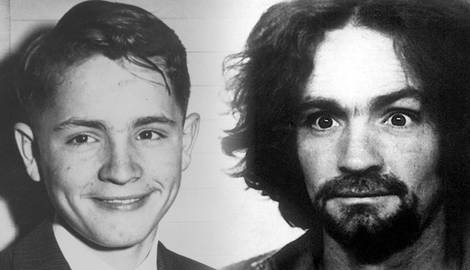
Charles Manson spent the vast majority of his life behind bars. He led the notorious Manson Family Cult and was convicted in 1971 of orchestrating a string of grisly murders, including the brutal slaying of Hollywood actress, Sharon Tate. Though he never killed anyone himself, Manson was charged with manipulating others into committing heinous crimes. Charlie Manson remains one of the most notorious criminals in American history. His image, name and deeds have come to symbolize the embodiment of evil in the American psyche.
Early Life

Charles Manson was born in 1934 in Cincinnati, Ohio, to 16-year-old Kathleen Ada Maddox, and Colonel Scott, a known con man who Manson never met. Before he was born his mother married William Manson, to whom he owes his name.
Charlie’s mother, herself a victim of a difficult childhood, was an alcoholic and petty criminal who ended up severely neglecting her son. She once attempted to sell him to a waitress for a pitcher of beer and was jailed for five years for robbery when Charlie was just 4 years old.
Manson’s childhood was filled with a series of moves between abusive relatives, foster homes, reform schools, and eventually prison. By 1969, the year of the infamous Tate-LaBianca murders, he had spent half of his life incarcerated and been convicted of robbery, car theft, and the rape of a fellow prison inmate.
Manson’s Music

While imprisoned at McNeil Island, Washington, Manson befriended Alvin “Creepy” Karpis, leader of the Ma Barker gang, who taught him to play the guitar. During this time, Manson began thinking about a career in music.
He was released from prison in 1967 and after becoming friends with Dennis Wilson of the Beach Boys in early 1968, recorded a demo album, released in 1970 as Lie: The Love and Terror Cult. His song “Cease to Exist” was reworked into “Never Learn Not To Love” for the Beach Boys 1968 album 20/20.
Despite his efforts, while his music career never took off his influence on popular music persists. Shock rocker Maralyn Manson is named after him and several bands, such as The Lemonheads, Guns N’ Roses, and Nine Inch Nails have covered or referenced his songs in their music.
The Family

Released from prison during the summer of love in 1967, Manson moved to San Francisco, became a small-time guru, and picked up a large group of mostly female followers. At its peak, the Family consisted of around 100 followers bound to Manson through a mix of sex, manipulation, and the heavy use of psychoactive drugs.
In early 1968 they lived for a short time with Beach Boy, Dennis Wilson, before being evicted and settling at Spahn Ranch – an old Hollywood movie set outside of Los Angeles. There, Manson intensified his control over the Family.
He began dosing his followers with several acid trips a day, manipulating their perception and exerting increasing control over their behavior. Manson planted the idea that he was Jesus Christ and professed to have had visions of a coming race war, “Helter Skelter,” named after the song by The Beatles.
The Tate-LaBianca Murders

Charlie Manson’s direct involvement in the Tate-LaBianca Murders remains a topic of fierce debate. Prosecutors to his trial argued that he ordered the murders because the previous owner of Sharon Tate’s house, Terry Melcher, had refused to produce a record for him. They also argued that he was motivated to start a race war.
Manson believed that Helter Skelter would be triggered by black-on-white racial violence. In the summer of 1969, the Family decided to start the war themselves. On August 8th 1969, Family members Tex Watson, Patricia Krenwinkle, and Susan Atkins murdered Sharon Tate and four others – Tate was eight months pregnant.

The next night, the group was joined by Leslie Van Houten and Manson himself. They drove to the house of Leno and Rosemary LaBianca. The couple were tied up by Manson and murdered by Watson and Krenwinkel.
Sharon Tate was stabbed 16 times and “PIG” was written on the front door in her blood. “WAR” was carved into Leno LaBianca’s stomach with a fork. The blood-scrawled message “HELTER SKELTER” was left on the walls of the crime scenes. The Family believed that black Americans would be blamed for the killings and the race war would begin.
Manson’s Legacy

While the Tate-LaBianca Murders were not the only killings by the Manson family, they shocked American society. Grisly details of the crime scenes and the specter of brainwashed drug-crazed youth killing innocents at random remain etched in public memory.
Charlie Manson was undoubtedly a product of a life spent in the penal system. Nonetheless, he stands today as a symbol of evil. For some, he was the devil incarnate. He described himself as a mirror, insisting that “anything you see in me is in you” – he also claimed to be “nobody.”
Manson died in prison from the complications of cancer in 2017; he was 83 years old. He spent 46 years in prison for his part in the Tate-LaBianca Murders. He protested his innocence until the end and never disclosed the motive for his crimes.










